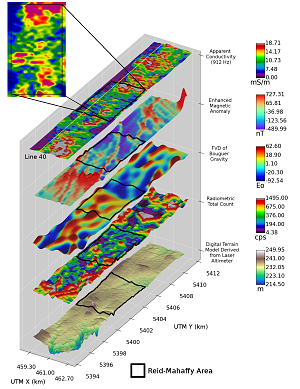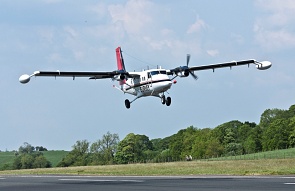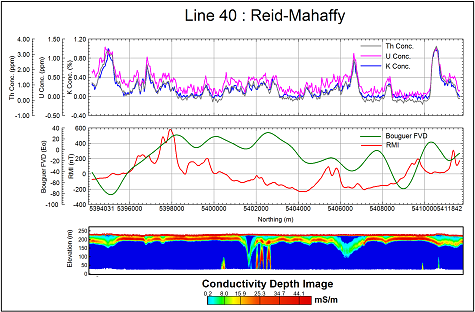
Multi-Parameter Surveys
Exploration success is vastly improved by using a
multi-parameter approach, whereby several complementary
geophysical techniques are used together to maximize
subsurface information. Sander Geophysics owns and
operates two DHC-6 Twin Otter survey aircraft that are
capable of acquiring multiple geophysical parameters
simultaneously. These parameters include frequency domain
electromagnetics, gravity, magnetics and gamma-ray
spectrometry, which can all be used together to provide a
more complete geological picture. Associated aircraft GPS
data as well as radar and laser altimeter data are also
recorded.

Figure 1: Reid-Mahaffy test
site data showing multiple data compone
Multi-Parameter Data
The electromagnetic data is provided by SGL's SGFEM
system, which is designed for high resolution mapping, and
consists of a four frequency (925, 3,005, 11,962, and
27,933 Hz) transmitter mounted in a wingtip pod and a
receiver mounted in a pod on the opposite wing.
Gravity data is provided by AIRGrav, a total field
gravimeter designed and built by SGL specifically for the
airborne environment, which is mounted inside the aircraft
cabin.
A total field magnetometer mounted in a rigid tail
stinger provides the magnetic data, and a gamma-ray
spectrometer with up to 3 boxes (50.4 litres downward
facing, 8.4 litres upward facing) of sodium iodide
crystals provides the radiometric data.

SGL´s de Havilland Twin Otter on
survey in Ireland
Reid-Mahaffy Geophysical Test Site
A survey using this multi-parameter system was flown over
the Reid-Mahaffy geophysical test site in Ontario to
demonstrate the system's capabilities over a typical
mineral exploration target with known geology and good
depth control. Using a primary (traverse) line spacing of
200 m, a total of 315 line kilometres were flown over the
test site and surrounding area at a speed of 90 knots (167
km/h) and at an altitude of 52 m.
Specialized Processing & Interpretation
The Reid-Mahaffy data were processed using SGL's suite of
processing tools, and an analysis of the data was
performed. Figure 1 shows the complementary nature of
multiple instruments. The first grid is the apparent
conductivity derived from the lowest frequency (912 Hz)
which tends to target deeper conductors. The principal
conductors of the Reid-Mahaffy area are clearly visible
and delineated by the east-west striking conductive zones
in the centre of the area. The magnetic anomaly grid shows
magnetic bearing targets, especially useful to delineate
certain dykes. The first vertical derivative of the
Bouguer gravity grid supports the other data sets by
imaging density contrasts which can help map geological
units and contacts. The radiometric data can potentially
identify geological units by measuring the quantity of
radioelements (potassium, uranium and thorium) common in
many rocks where they are outcropping or where in situ
soil is present. Finally, a high quality digital terrain
model can be derived from the laser altimeter showcasing
very detailed terrain.
Figure 2 shows a cross section of Line 40 (location shown
in Figure 1) that crosses over the conductors of interest.
The top pane shows the radiometric data, and the second
pane shows the first vertical derivative of the Bouguer
gravity combined with the magnetic anomaly data. The
bottom pane is a Conductivity Depth Image (CDI) whereby
all frequencies from the SGFEM system are used to generate
a suite of conductivity values with associated depths. The
result is a relatively fast product that can help localize
targets of interest, and can even map overburden thickness
due to the great near surface resolution of the SGFEM
system. The CDI clearly shows multiple conductors that
correlate with the apparent conductivity data.
In some settings, various parameters may correlate to
each other (either directly or inversely), or one may
image a feature that the others do not by mapping a
different rock property. A much better interpretation can
be generated by having all of these tools to provide a
more complete geological picture.

Figure 2: Test line showcasing
multiple parameters in profile plus CDI generated from
SGFEM system
|